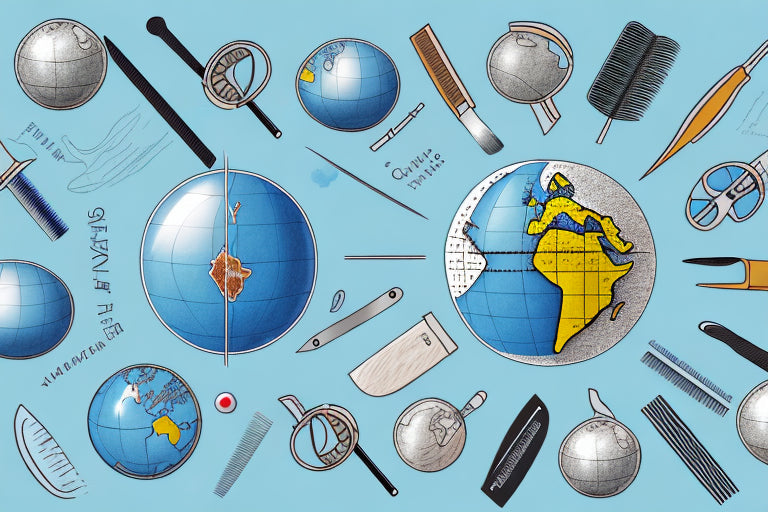How to Take Care of Your Hair in Different Climates
Posted by MORFOSE COSMETICS

How to Take Care of Your Hair in Different Climates
As individuals, our bodies react differently to changes in our environment. Similarly, our hair can also undergo changes depending on the climate we are exposed to. Whether it's the humidity, dryness, or extreme cold, our hair demands different care regimens and products to thrive.
Understanding the Effects of Climate on Hair
Climate plays a significant role in how our hair looks and feels. Whether it's too hot, too cold, too dry, or too humid, changes in the climate can affect your hair's health and appearance. Understanding the effects of climate on your hair can help you take better care of it and keep it looking healthy and beautiful.
Humidity and Hair
Humidity is one of the most challenging environmental factors that can affect your hair. When the air is humid, it contains a lot of moisture. This excess moisture can cause the hair shaft to absorb water, resulting in frizz, tangling, and flatness. Humidity can also make your scalp and hair prone to fungal and bacterial infections, which can lead to hair loss and other complications.
To combat the effects of humidity on your hair, it's essential to keep your hair hydrated and moisturized. Using a leave-in conditioner or hair oil can help to seal in moisture and prevent frizz. You can also try using a hair serum or anti-humidity spray to protect your hair from the effects of humidity.
Dryness and Hair
On the other hand, dry climate conditions can strip your hair of its natural oils, causing it to become brittle, dry, and prone to breakage. The absence of moisture can also make your scalp itchy, flaky, and prone to dandruff complications. To keep your hair healthy in dry climates, it's essential to use a moisturizing shampoo and conditioner. You can also use a hair mask or deep conditioning treatment once a week to help restore moisture to your hair.
Temperature and Hair
The temperature can also affect your hair's health and appearance. Extreme temperatures, whether cold or hot, can cause hair strands to weaken, resulting in dryness, breakage, and thinning. In cold weather, the dry air can cause your hair to become static and prone to breakage. In hot weather, the sun's UV rays can damage your hair's cuticle, causing it to become dry and brittle.
To protect your hair from extreme temperatures, it's essential to wear a hat or scarf in cold weather and use a heat protectant spray when using hot styling tools. You can also use a leave-in conditioner or hair oil to protect your hair from the sun's UV rays.
By understanding the effects of climate on your hair, you can take steps to keep your hair healthy and beautiful, no matter what the weather is like outside.
Hair Care Tips for Humid Climates
If you live in a humid climate, keeping your hair looking healthy and beautiful can be an uphill task. However, there are some expert tips you can use to ensure your hair remains healthy and frizz-free.
Humidity can wreak havoc on your hair, leaving it frizzy, dull, and lifeless. But with the right hair care routine, you can keep your locks looking their best, no matter how humid it gets. Here are some additional tips to help you manage your hair in humid weather:
Choosing the Right Hair Products
The first step to tame frizz in humid weather is to choose the right hair products. Opt for anti-frizz shampoos, conditioners, and leave-in treatments that can tame flyaways and keep your hair hydrated and healthy. Look for products that contain natural ingredients like argan oil, coconut oil, and shea butter, which can help nourish and protect your hair from the damaging effects of humidity.
In addition to using the right products, it's also important to avoid over-washing your hair, as this can strip it of its natural oils and make it more prone to frizz. Instead, try washing your hair every other day or using a dry shampoo in between washes to keep your hair looking clean and fresh.
Managing Frizz and Tangles
To prevent frizz, avoid using heavy styling products that can weigh down your hair. Instead, opt for lightweight styling products and a wide-tooth comb to detangle your hair without causing breakage. When blow-drying your hair, use a diffuser attachment to help distribute heat evenly and minimize frizz.
If you're prone to tangles, consider using a leave-in conditioner or detangling spray to make combing your hair easier. You can also try using a silk or satin pillowcase, which can help reduce friction and prevent tangles while you sleep.
Protective Hairstyles
Another great way to manage your hair in humid weather is to wear protective hairstyles. Braids, buns, and twists are all great options, as they can help keep your hair in place and prevent frizz. Plus, they're easy to style and can be dressed up or down depending on the occasion.
When choosing a protective hairstyle, be sure to consider your hair type and length. If you have long hair, a braided updo or a messy bun can be a great option. If you have short hair, try a sleek pixie cut or a curly bob to keep your hair off your face and neck.
By following these tips and incorporating them into your hair care routine, you can keep your hair looking healthy and beautiful, no matter how humid it gets outside.
Hair Care Tips for Dry Climates
If you live in a dry climate, keeping your hair looking hydrated and healthy can be a bit challenging. However, there are some expert tips that you can use to keep your hair looking its best.
Deep Conditioning Treatments
Deep conditioning treatments are essential if you live in a dry climate. They provide an extra boost of moisture and nourishment to your hair, leaving it looking shiny and soft. Consider using a hydrating hair mask at least once a week to keep your hair healthy and shiny.
Another way to add moisture to your hair is to use a leave-in conditioner. This type of conditioner can be applied after you wash your hair and left in to provide ongoing hydration throughout the day.
Preventing Breakage and Split Ends
Dry climates can cause your hair to become brittle and prone to breakage. Protect your hair by avoiding heat styling tools such as straighteners and curling irons. Instead, opt for heatless styling methods such as braids, buns, or twists.
Regular trims are also important for preventing breakage and split ends. Aim to get a trim every 6-8 weeks to keep your hair healthy and strong.
In addition, consider using a silk or satin pillowcase. These materials are gentler on your hair and can help prevent breakage while you sleep.
Protecting Your Hair from the Sun
The sun can be particularly damaging to hair in dry climates. To protect your hair from the sun's harmful rays, consider wearing a hat or scarf when you're outside.
You can also use hair products that contain UV protection. These products can help shield your hair from the sun's rays and prevent damage.
Finally, avoid spending too much time in chlorinated or salt water. These types of water can be particularly drying to your hair and can cause damage over time.
By following these expert tips, you can keep your hair healthy and hydrated even in the driest of climates.
Hair Care Tips for Cold Climates
Winter can be a magical time of year, but it can also be harsh on your hair. The cold weather, snow, and wind can leave your hair dry, brittle, and prone to split ends. However, with a few expert tips, you can protect your hair during the colder months and keep it looking healthy and vibrant all winter long.
Protecting Hair from Cold Temperatures
One of the most important things you can do to protect your hair during the winter is to shield it from the cold temperatures. When the air is cold and dry, your hair can become fragile and brittle, leading to breakage and split ends. To prevent this, wear a hat or beanie to keep your head warm and protect your hair from the cold. Additionally, avoid going outside with wet hair, as it can freeze and cause breakage. Instead, blow-dry your hair before heading out into the winter wonderland.
Moisturizing Hair Care Routine
Snow and cold weather can cause your hair to lose its natural oils, leaving it dry, frizzy, and difficult to manage. Therefore, it's important to keep your hair moisturized during the winter months. Start by using a hydrating shampoo and conditioner, which will help to restore moisture to your hair. Additionally, consider using a hair oil or serum to add extra protection and shine. These products will help to lock in moisture and protect your hair from the harsh winter elements.
Winter Hair Accessories
During the winter, your hair needs extra protection from the elements. In addition to wearing a hat or beanie, consider using a silk or satin-lined beanie to protect your hair from friction and breakage. These materials are gentle on your hair and will help to keep it looking healthy and shiny. You can also add headbands, scarfs, and other winter accessories to keep your hair looking stylish and protected. Just make sure that any accessories you use are gentle on your hair and won't cause breakage or damage.
By following these hair care tips, you can ensure your hair remains healthy, shiny, and vibrant no matter the climate. So take care of your hair this winter, and it will thank you with a luscious, healthy glow.


